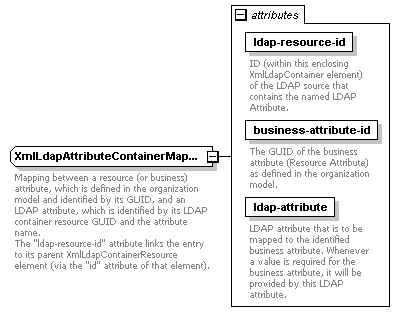| diagram |  |
||||||||||||||||||||||||||||||
| namespace | http://ldap.api.de.n2.tibco.com | ||||||||||||||||||||||||||||||
| used by |
|
||||||||||||||||||||||||||||||
| attributes |
|
||||||||||||||||||||||||||||||
| annotation |
|
||||||||||||||||||||||||||||||
| source | <xs:complexType name="XmlLdapAttributeContainerMapping"> <xs:annotation> <xs:documentation>Mapping between a resource (or business) attribute, which is defined in the organization model and identified by its GUID, and an LDAP attribute, which is identified by its LDAP container resource GUID and the attribute name. The "ldap-resource-id" attribute links the entry to its parent XmlLdapContainerResource element (via the "id" attribute of that element).</xs:documentation> </xs:annotation> <xs:attribute name="ldap-resource-id" type="xs:long" use="required"> <xs:annotation> <xs:documentation>ID (within this enclosing XmlLdapContainer element) of the LDAP source that contains the named LDAP Attribute.</xs:documentation> </xs:annotation> </xs:attribute> <xs:attribute name="business-attribute-id" type="xs:string" use="required"> <xs:annotation> <xs:documentation>The GUID of the business attribute (Resource Attribute) as defined in the organization model.</xs:documentation> </xs:annotation> </xs:attribute> <xs:attribute name="ldap-attribute" type="xs:string" use="required"> <xs:annotation> <xs:documentation>LDAP attribute that is to be mapped to the identified business attribute. Whenever a value is required for the business attribute, it will be provided by this LDAP attribute.</xs:documentation> </xs:annotation> </xs:attribute> </xs:complexType> |
WSDL documentation generated by XMLSpy WSDL Editor http://www.altova.com/xmlspy